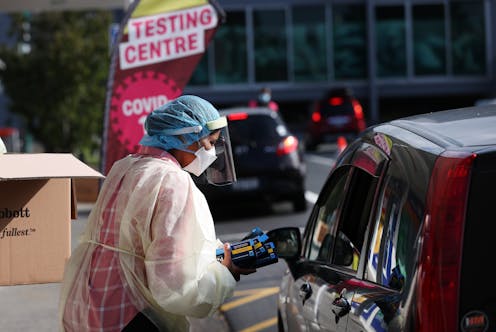NZ's confirmed COVID case numbers are rising fast, but total infections are likely much higher – here's why
- Written by Dion O'Neale, Project Lead - COVID Modeling Aotearoa; Senior Lecturer - Department of Physics, University of Auckland; Principal Investigator - Te Pūnaha Matatini, University of Auckland

With Aotearoa New Zealand’s move into phase 3[1] of its response to the Omicron outbreak, new definitions and protocols for testing and isolation will mean new ways of measuring the impact of COVID-19.
Broadly speaking, there are two aspects to this new regime. The first relates to the changing definitions of who counts as a close contact, and what their isolation requirements are.
The second concerns testing processes, advice for who should get tested when, what sort of test they should take, and how the result is recorded. Switching to phase 3 means a switch to predominantly using rapid antigen tests (RATs).
Testing policy is important because the number of confirmed or probable cases informs our estimate of the number of underlying infections.
New confirmed cases are a lagging indicator of new infections, but a leading indicator of other important metrics like hospitalisations. The more we know about who is newly infected and where, the better we can plan individual and community responses to the outbreak.
RATs and risk
With the high case numbers[2] we’re now seeing with Omicron, speed is key in returning test results. Quick results mean people can modify their behaviour accordingly and isolate if necessary. The sooner people receive a positive result, the sooner they can notify recent contacts, and those people can also isolate.
When case numbers are high, the risk of a false positive from a RAT is very low. This means the extra value from having a more sensitive PCR test is reduced compared with when we had lower case numbers.
Read more: As New Zealand's Omicron infections rise rapidly, genome surveillance is shifting gears[3]
Conversely, when case numbers in the community are high, there is a risk of false negative results on a RAT for someone who either has symptoms or is a close contact of a confirmed case.
In such cases the prudent course of action would be to take a second test – either another RAT or a PCR test – and to assume there is still a decent chance you may be infected.
People who have no known exposure to a confirmed case, and no symptoms, can be relatively confident in the accuracy of a negative result from a RAT. And regardless of test results, anyone with COVID-like symptoms should be isolating until they recover from whatever is causing those symptoms, COVID or otherwise.
Estimating actual infection numbers
The move to phase 3 acknowledges that infection and confirmed cases are becoming high enough that many of the processes for monitoring and planning will be stretched and may become inaccurate.
As the number of infections rise, we can expect the “case ascertainment rate” (CAR) will start to fall. The CAR is a measurement of the percentage of total infections at a given point in time that are turned into confirmed cases.
Read more: 15 things not to do when using a rapid antigen test, from storing in the freezer to sampling snot[4]
That is, given an observed number of confirmed cases, how many infections do we think are actually in the community, including those that are unconfirmed?
Keeping track of this metric at different stages of the outbreak is important. When isolation requirements for close contacts relax, infections may increase, while fewer people will be eligible for testing.
Or, people may test positive on a self-administered RAT but not report it. Both of these lead to higher numbers of unconfirmed infections.
Why accurate numbers matter
The only way to accurately estimate the CAR is through an “infection prevalence survey”. An example is the UK’s Office of National Statistics (ONS) survey[5], one of the strongest aspects of the UK’s otherwise patchy COVID response.
This randomised survey tries to directly measure the fraction of people who are infected with COVID at any point in time. A well-designed survey makes sure to sample sufficient people in different demographic groups and with different infection risk factors.
Read more: How accurate is your RAT? 3 scenarios show it's about more than looking for lines[6]
Modelling can estimate the number of infections in different populations, subject to different assumptions. But without an infection prevalence survey, or equivalent data, only confirmed cases can be directly observed.
Since confirmed cases are an unknown fraction of total infections, and this fraction changes over time, it’s important to be able to accurately estimate the underlying infection numbers to validate such modelling.
And since infection numbers are a leading indication for hospitalisations, they are valuable for planning adjustments to processes or policies, such as testing or isolation.














